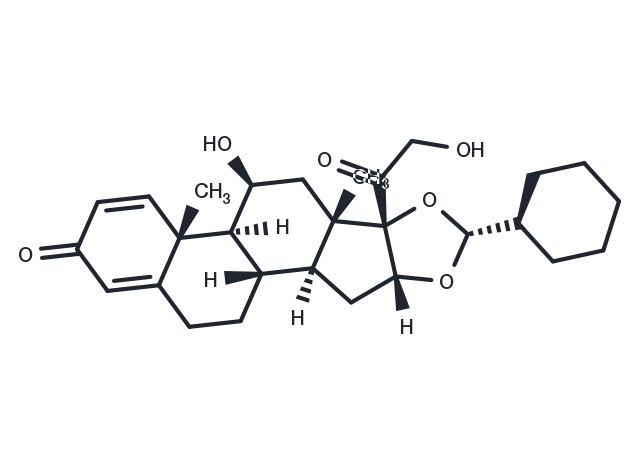Powder: -20°C for 3 years | In solvent: -80°C for 1 year


Desisobutyryl-ciclesonide has an affinity for glucocorticoid receptors. Desisobutyryl-ciclesonide is the active metabolite of Ciclesonide.

| Pack Size | Availability | Price/USD | Quantity |
|---|---|---|---|
| 2 mg | 5 days | $ 68.00 |
| Description | Desisobutyryl-ciclesonide has an affinity for glucocorticoid receptors. Desisobutyryl-ciclesonide is the active metabolite of Ciclesonide. |
| In vitro | Ciclesonide is an inhaled glucocorticoid with little affinity for glucocorticoid receptors. When converted into an active metabolite Desisobutyryl-ciclesonide, it is very effective in down-regulating the proinflammatory activity of airway parenchymal cells in vitro. 0.3-3.0μMCiclesonide and Desisobutyryl-Ciclesonide dose-dependently inhibited the proliferation of peripheral blood mononuclear cells to Candida albicans, but Desisobutyryl-Ciclesonide had a higher inhibitory effect. Significant proliferation of PhlP5 was observed only in cultures of ectopic subjects: effective downregulation has been detected at 0.03 μM Ciclesonide and 0.003 μM Desisobutyryl-Ciclesonide (at 3 μM Ciclesonide and 0.03 μM Desisobutyryl-ciclesonide Completely suppressed). 3μM Ciclesonide and Desisobutyryl-ciclesonide reduced the proportion of PhlP5-specific T cell embryonic cell proliferation and interleukin 4 producing cells. In PBMC cultures of atopic patients, both Csonide (CIC) and desisobutyryl-Crossonide (des-CIC) induced dose-dependent down-regulation of PhlP5-induced proliferation. At 0.03 μM Ciclesonide and 0.003 μM Desisobutyryl-Ciclesonide (p <0.001, each comparison), the effect is already significant (an earlier complete inhibition was observed at 3 μMCiclesonide and 0.03 μMDesisobutyryl-Ciclesonide. At 0.003 μM ( p<0.05), 0.03μM (p<0.001) and 0.3μM (p<0.05), the inhibitory activity of desisobutyryl-ciclesonide on PhlP5-induced PBMC proliferation was higher than that of Ciclesonide. |
| Synonyms | CIC-AP, Ciclesonide active principle |
| Molecular Weight | 470.6 |
| Formula | C28H38O6 |
| CAS No. | 161115-59-9 |
Powder: -20°C for 3 years | In solvent: -80°C for 1 year
DMSO: 50 mg/mL (106.25 mM)
You can also refer to dose conversion for different animals. More
bottom
Please see Inhibitor Handling Instructions for more frequently ask questions. Topics include: how to prepare stock solutions, how to store products, and cautions on cell-based assays & animal experiments, etc.
Desisobutyryl-ciclesonide 161115-59-9 Others Desisobutyryl ciclesonide CIC-AP Desisobutyrylciclesonide Ciclesonide active principle inhibitor inhibit
